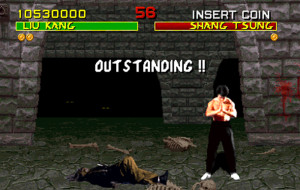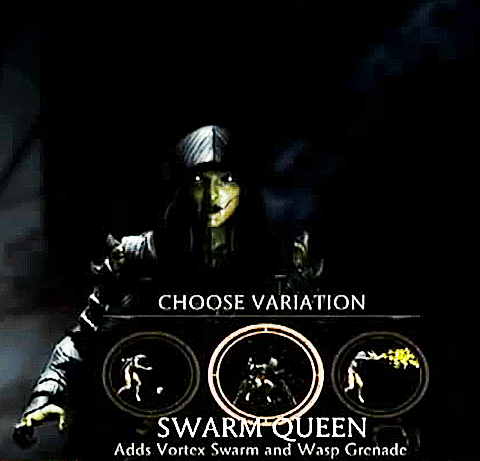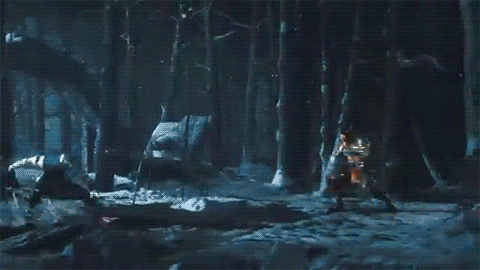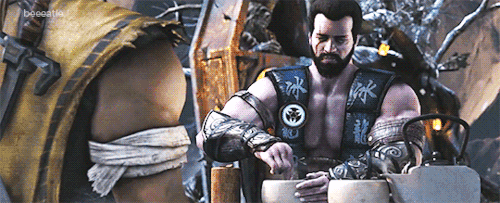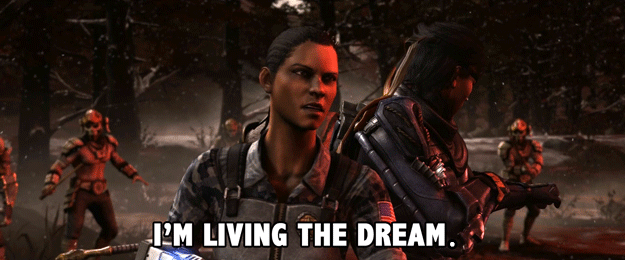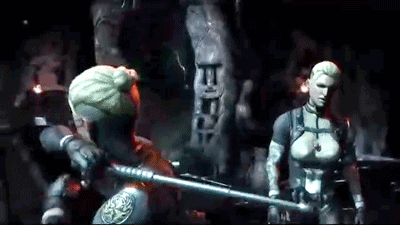During a school field trip/reward for doing so well on our standardized tests, I found myself at the bowling alley, staring at this game machine/arcade cabinet almost demanding me to give it my money. I couldn’t resist, watching the screen flash to reemphasize the game’s title, “Mortal Kombat”. I only got a couple of fights in before I had no quarters left to give. What I thought would be my first and potentially last experience with this fighting game proved to be the beginning of a legacy in my personal gaming experience.
By Christmas of 1993, my parents got me the Sega Genesis I wanted for over a year. Sadly for me, the amount of money spent to complete my Christmas list put the rather expensive “Mortal Kombat” on the backburner (especially since the Genesis came with “Sonic the Hedgehog 2” so it wasn’t necessary for me to have another game). But my dad refused to let his son be disappointed about not playing the game he wanted. So if he couldn’t buy the game, my dad figured renting would be the next best thing. He was right.
I became nothing short of a “MK” fanatic as the years progressed and the games just kept coming. The highpoint of my “Mortal Kombat” fandom occurred a little over a year after playing the original “MK” for the first time with the release of “Mortal Kombat II”. I was obsessed with “Mortal Kombat II” and spent many hours playing against the computer, my dad and friends until I felt like I was one of the best in the world. Thanks to life, school and money (more money, more games I could buy – causing me to not focus solely on one game for months at a time like I did as a kid), my time with the future “MK” games wasn’t as plentiful or life changing. Add that to the fact the “Mortal Kombat” franchise struggled to retain its greatness as the years progressed.
The explosion of 3D fighting games forced “Mortal Kombat” developers to embrace the new frontier and produced a mixed bag of results. But in 2011, the series returned to its roots – putting the fighters on a 2D plane even though the game featured 3D models. The game was widely received as a return to form and produced, arguably, the greatest “Mortal Kombat” since “MK II”. I too loved “Mortal Kombat (2011)” and it left me looking forward to the inevitable sequel that would be named “Mortal Kombat X”. It was a week-one purchase for yours truly and hopefully another worthy experience in “Mortal Kombat’s” legacy.
Did I Complete “Mortal Kombat X”?
After downloading the one gigabyte-plus patch to help the game’s online component and playing a quick tutorial referencing some of the additions to the game (while refreshing my fingers and mind for the task at hand), it was off to the races with another go-round starring one of my favorite video game franchises. But the problem with “completing” a fighting game is completion comes with a personal goal (or goals). Unlike the days of “Mortal Kombat” (single digits), “MK X” features a variety of modes; but only one has a completion rating: Story Mode. Picking up where “Mortal Kombat (2011)” left off, the player is given a chance to test out their skills while exploring the ever-expanding universe that has become something of a revolutionary concept in the fighting game genre. The mode lasts about a third less than the previous game’s version, but is a perfect starting point for players looking to test the depths of their potential skills with a variety of the fighters available.
For offline players, the Klassic Tower returns – a mode where the player can take one character and fight ten other fighters in the game until they defeat “X’s” main boss Shinnok and witness the character-driven ending starring the victor. There are other towers in the game including the button-smashing “Test Your Might” from the original “Mortal Kombat” and “Living Towers” that mimic the “Klassic Tower”, but add stipulations to fights like random freeze missiles shooting from the sky to paralyze fighters. These “Living Towers” change on an hourly, daily and weekly basis, giving the player something different almost every time they play.
For those who are up to the task, “Mortal Kombat X” gives you the option of playing against others online. Instead of just having simple one-on-one battles, “MK X” allows players to start their own rooms/lobbies, add stipulations to their fights with “Test Your Luck”, and even has a “King of the Hill” mode where the player must defeat the reigning champion and defend his/her throne as long as he/she can.
Thanks to the various achievement/trophies attached to “Mortal Kombat X”, completing the game becomes a lot easier thanks to a checklist that asks the player to try out everything and everyone. And that’s exactly what I did (and then some).
Did “Mortal Kombat X” Live Up to the Hype?
NetherRealm Studios entered this generation of gaming with a solid foundation based off of their prior games “Mortal Kombat (2011)” and the D.C. Comics-based “Injustice: Gods Among Us”. It’s pretty obvious how proud NetherRealm Studios is of their highly acclaimed previous works from the simplicity of left-right kicks and punches, an overpowered uppercut, special maneuvers that can be powered up, debilitating throws, combos, both simple and complicated, aplenty and the feel that this is the most efficient “Mortal Kombat” ever. While “MK X” borrows certain traits from those titles (mostly “Injustice”), the game looks to innovate in the franchise; and fighter games in general with character variations. Each of the original twenty-four characters has three distinct variations that can be chosen by the player. The variations give each character several different moves (though every character has a base set of moves that stay the same no matter the variation) and potential strategies that can prove effective and outright dangerous.
Unlike previous “Mortal Kombat” games (and fighting games in general), the chance to find the character that works best for your play style might not come with the specific fighter, but the character’s style. I, for one, have never been a Jax player (ironically enough, he was my dad’s favorite). But Jax’s “Pumped Up” variation has him as one of my main characters that I’ll take through both offline and online competition in a moment’s notice.
Another addition to the franchise is actually a return but in a better, more rewarding fashion: Brutalities. Not seen since the days of “Mortal Kombat Trilogy”, the long awaited moves that were only seen after a player completed ridiculous combos have come back in a different form. Rather than force the player to learn and execute combos to see some extra ribcages and tibias fly across the screen from an exploding body, “MK X” gives gamers certain requirements that must be completed at the tail-end of the final round of a fight. While some of the necessities are more aggravating than others – specifically the requirements that ask for the opponent to be blocking, ducking or jumping – those simply paying attention can pull off a majority of these barbaric maneuvers.
The variety of ways a person can end the match with a figurative (or, at times, literal) bang without hearing the phrase “Finish Him/Finish Her” is almost more impressive than the series’ staple, “Fatalities” (which are, of course, back with a bloody vengeance alongside their non-match ending cousin, “X-Ray” attacks). Also added to the finishing sequences is “Faction Kill” – a quick input that allows people to finish defeated opponents in a gruesome fashion no matter the character responsible.
From an aesthetic standpoint, “Mortal Kombat X” forgoes that cartoony, unrealistic style seen in previous games. “MK X” surprised me as the animation in motion looked better from a firsthand experience than any post-announcement trailer would make one believe. Behind the fighters are usually lush, interactive backgrounds that vary from the snow-covered forests of Outworld to an Earthrealm metropolis decaying due to war occurring at every corner (including a man getting attacked by wild dogs in the background and people scavenging random wrecked automobiles). “Mortal Kombat X” is absolutely gorgeous and one of the best looking eighth generation games to date.
But it’s not all gore and greatness when it comes to NetherRealm Studios’ latest offering. Probably one of the biggest disappointments when it comes to “MK X” is the game’s story mode. Coming off the heels of a fantastic retelling and re-imaging of the first three “Mortal Kombat” games in “MK (2011)”, “Mortal Kombat X” picks up not long after the previous game left off. After thirty minutes or so, the story pushes the player some twenty years into the future where new characters are introduced, alliances are forged and broken, and Sub-Zero has a tea party.
Lasting only four to five hours (depending on how well you play), the story based on families and young individuals destined for greatness coming of age through violence and, at times, diplomacy, the story mode struggles to achieve the levels of excellence set by it predecessor mostly due to the fact it doesn’t have the time to give players a reason to care about the new characters introduced other than, “Oh, that’s Johnny Cage’s daughter,” and “Jacqui and Takeda sittin’ in a tree.” Characters from the older “MKs” are either relegated to the background or are treated as punching dummies before their time in the spotlight comes to an end (and that’s not mentioning the random cameos like scenes featuring Bo Rai Cho and Sareena).
Add that to the fact the bosses themselves feel like wimps and the ability to care becomes weaker as the story progresses. What makes the story even worse is the fact it isn’t even the entire story. To understand the depths of characters both past and present, one must invest time and money into the “Mortal Kombat X” comic book (a series that is on-going, mind you). Essentially, you don’t get the full story of “Mortal Kombat X” by playing “Mortal Kombat X”.
From a gameplay perspective, the addition of variations to all of the characters does add some depth to each fighter, but the truth is one variation of three for each kombatant is usually superior compared to the rest – giving players no reason to learn how to play with a character’s trinity of variations for anything other than grinding toward a trophy/achievement.
But the biggest complaint associated with “Mortal Kombat X” has to be its online mode. While “MK (2011)” wasn’t the smoothest ride when it came to playing online, it appeared NetherRealm Studios learned their lesson in regards to presenting a fighting game in an online world. Sadly, we “MK” fans were wrong. The game struggled in delivering a lag-free, input delay (the time it takes for a character to react to the button you pressed on your controller) efficient game from day one (remember that patch mentioned earlier). But as the weeks went on, the online functionality got better. You could pull off combos and special maneuvers without much difference than you would offline. But by the release of The Predator DLC character, online became a mess. Input delay was worse than ever. Connections could easily be lost. As of now, “Mortal Kombat X’s” online functionality is hit or miss with odds leaning toward “miss” on any average day. Like many fighting games I enjoy, online play has become essential for me to keep playing once I complete all the Klassic Towers and trophies. Unfortunately for “MK X”, my days of playing online have come to a halt.
There are other negatives regarding this game including the almost unnecessary and practically useless “Faction Wars” that allows players to pick one of five factions to represent and help earn points for by completing various challenges during the week for the right to earn a secret Faction Kill and some koins. As the months have progressed, the wars have turned into a running joke of, “Will Special Forces ever lose?” after everyone jumped ship from the Lin Kuei faction in hopes of completing an achievement/trophy. The aforementioned “Living Towers” are suffering from stagnation thanks to reusing of the same towers after a few months of hourly changes. And the literal dungeon crawling mode known as “The Krypt” is a lot more time consuming than rewarding as a player goes through various areas spending koins won in battles to unlock various items including new fatalities or brutalities. But the unlocked items are usually concept art and music from the various stages played in the game. And don’t forget about the level of creepiness that comes with situations like Jax ripping his daughter’s arms off and snuffing a cigarette on her tongue, or Cassie hitting her dad in the testicles so hard his head flies off.
But none of these minor “negatives” hurt the overall experience of “Mortal Kombat X” (the same thing applies to the DLC that isn’t necessary to enjoy the game, just a optional addition for gamers who want to play as characters such as the aforementioned Predator, Jason Voorhees, or Goro – who was given a Living Tower so people who didn’t pay for him had the chance to play with him for a short period of time).
Should You Play “Mortal Kombat X”?
Even with its faults, “Mortal Kombat X” has been one of the most enjoyable experiences of 2015 for me; as well as one of the most enjoyable experiences as a “Mortal Kombat” fan I’ve ever had. “MK X” delivers the innovation necessary for the franchise to standout beyond the trait that made it memorable when it was first released while retaining the gameplay style that has become synonymous with the series since its sixth generation iterations. I’ve probably put in more time with “X” than its predecessors in a short period of time and found myself wanting more in the best way possible. If you’re a fan of the franchise, you’ve probably already purchased the game. But for those waiting around for “The Komplete Edition”, you’re losing time on one of the best games of 2015. And for those who aren’t in either camp (or faction) definitely give the game a try if you’re remotely interested in fighting games. I’m looking forward to see what the people at NetherRealm Studios have prepared for the inevitable next “Mortal Kombat” game. But until then … here are some more Brutalities to turn your stomach.



